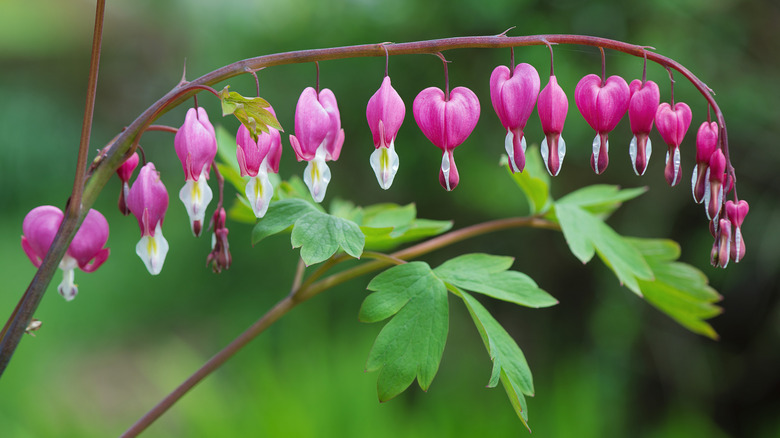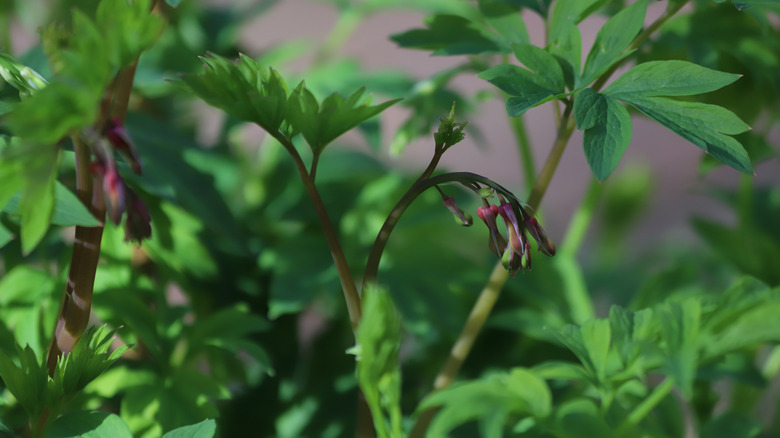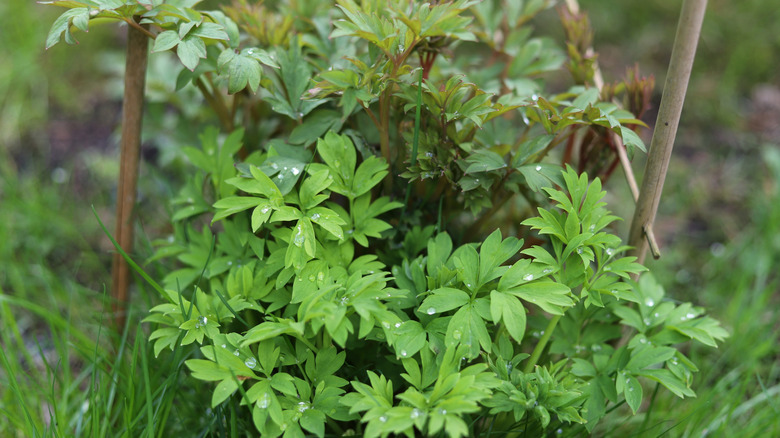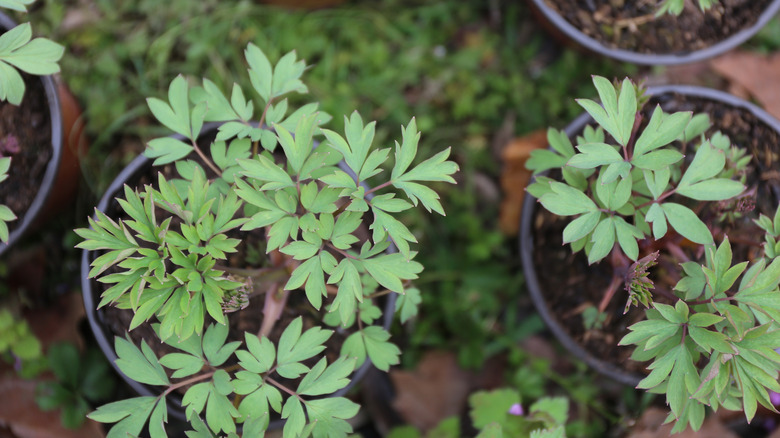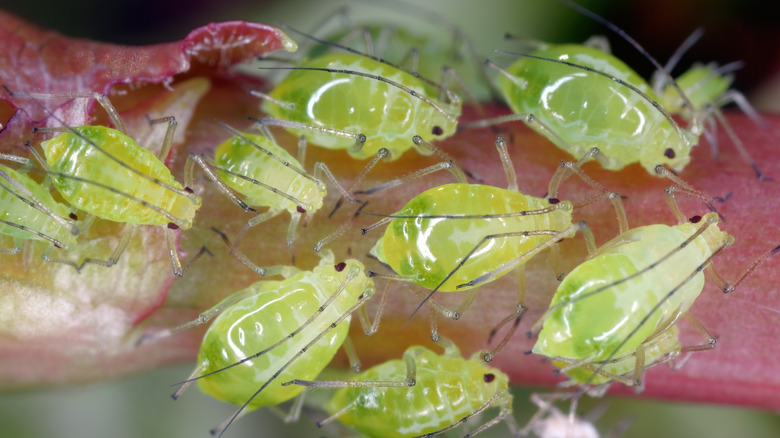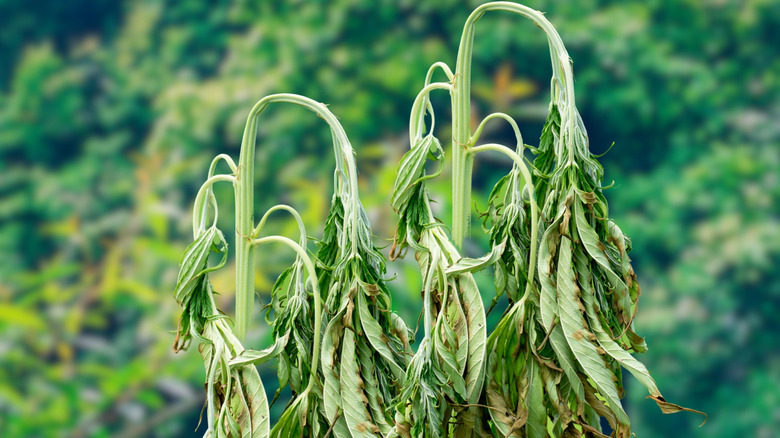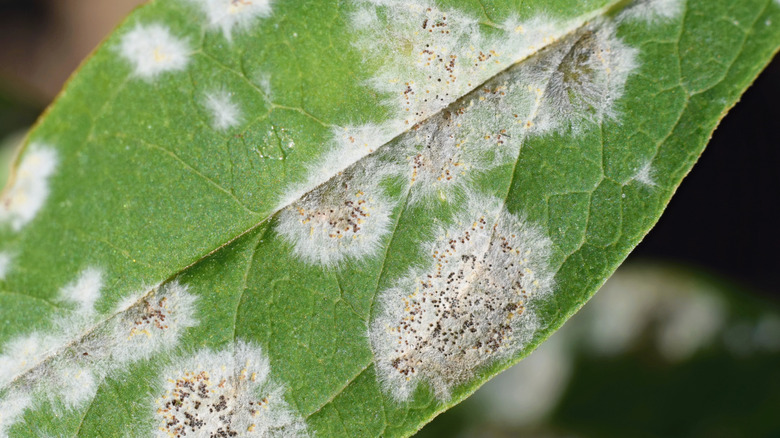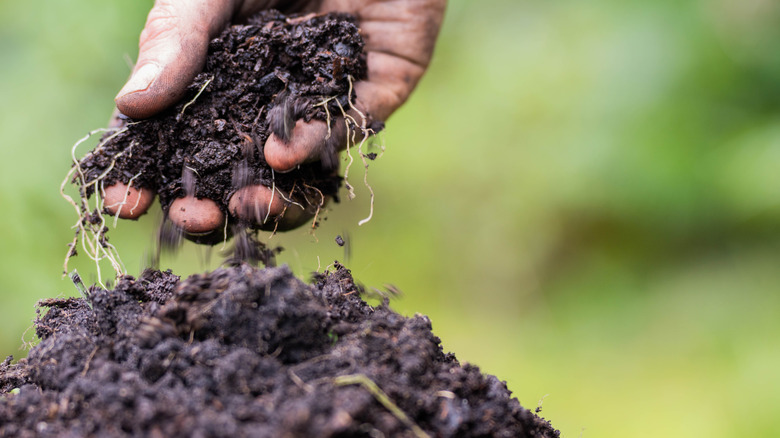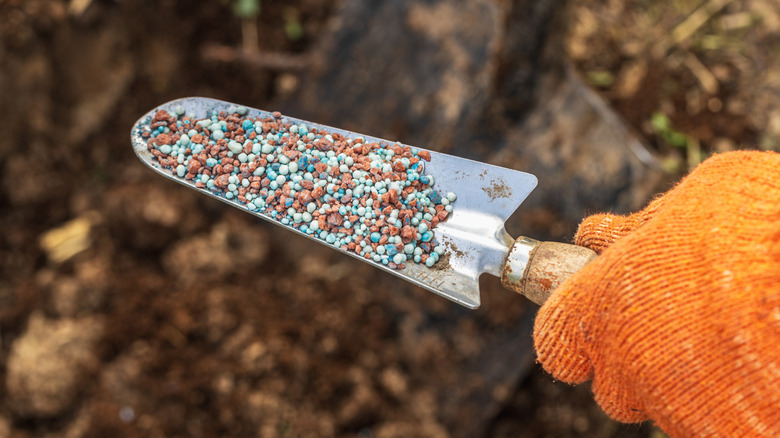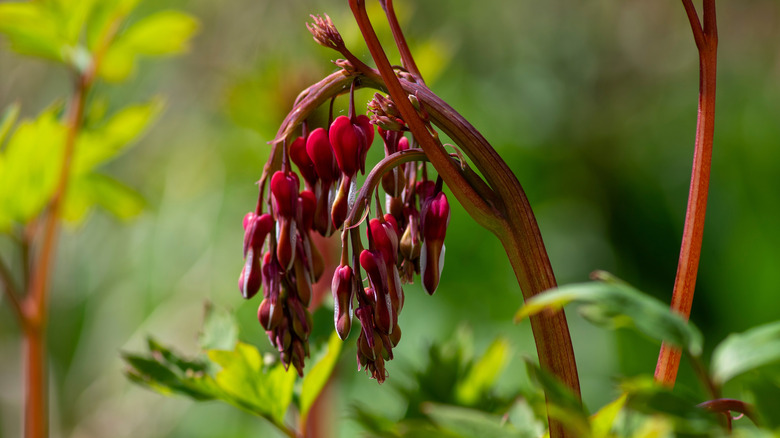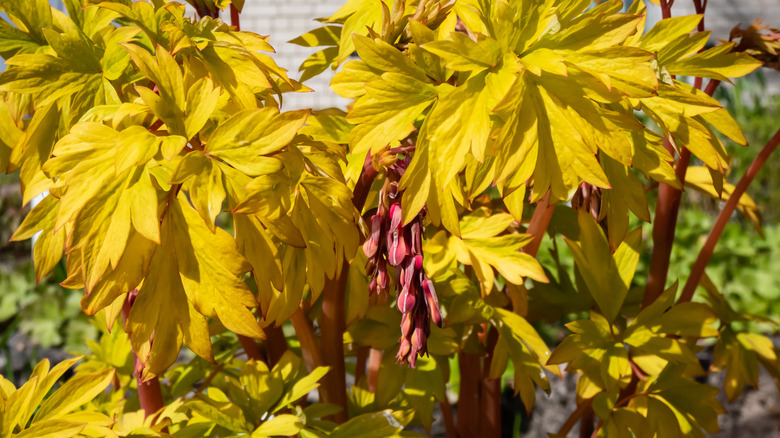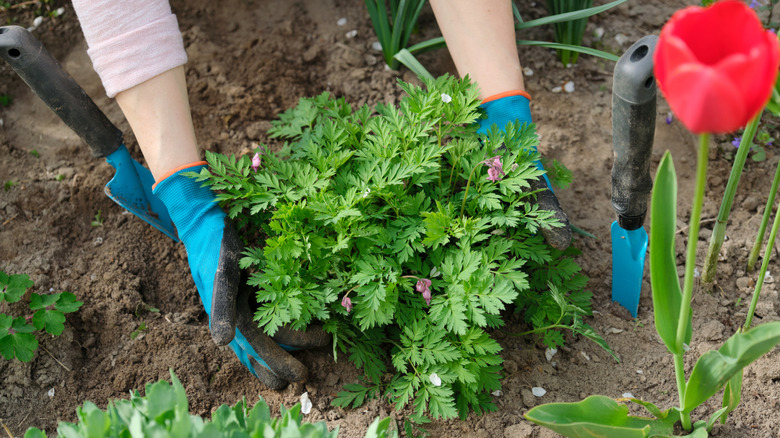All The Reasons Why Your Bleeding Hearts Aren't Growing Or Blooming
When creating a dreamy cottage garden, you can't go wrong by adding bleeding hearts (Lamprocapnos spectabilis, formerly Dicentra spectabilis) to the display. This herbaceous perennial gets its common name from its distinctive pink or white heart-shaped flowers that each have a teardrop-like inner petal that hangs below, appearing as though they're dripping from the arching stems. However, if your plant isn't growing properly or it ceases to put out blooms, you may be wondering why it's not giving your yard its usual charm.
Once established, bleeding hearts are low-maintenance beauties that typically bloom for 4-6 weeks before going dormant as the sun heats up in the summer. Bleeding hearts tend to be tough plants, so if they're not performing their best, there's likely an underlying cause, like pests or disease. First, go back to basics and make sure you're meeting your plant's care requirements. To successfully care for your bleeding heart plant, place it in a partially shaded area in well-drained soil and keep it moist during the growing season. Next, search for additional clues, like unusual textures on the soil or plant, changes in leaf shape or color, and anything else that seems off. From there, you can more easily narrow down which of the reasons below are preventing your bleeding heart from growing or blooming.
It's the wrong time of year
Spring has arrived, and it's the time of year when your garden starts to burst with color. But one plant may be lagging behind — your bleeding heart. Depending on the climate, bleeding hearts typically bloom between spring and early summer, so it may take some time for your plant to wake up from its dormancy and put out blooms. Alternatively, some gardeners purchase these plants hoping for heart-shaped flowers around Valentine's Day, but this is only possible if the rhizomes were cold-treated and forced indoors during late winter. Outdoors, however, the timeline is much more dependent on weather and regional conditions.
If it's still early in the season, it may be a few more weeks before those delicate pink pendants start to appear. In the meantime, the best way to encourage blooms is to continue providing the best care. Keep your plant in a lightly shaded area, make sure the soil is consistently moist, and apply a light application of fertilizer at the beginning of the growing season. Give your bleeding heart some time to warm up as it exits its dormant period, and your plant will likely reveal its pretty flowers by early summer.
The plant is too young
If your bleeding heart plant is still within its first year of growth or was recently propagated, the lack of blooms may simply come down to age. This species takes some time to establish itself, spending the first growing season on developing its root system and foliage. When grown from seed, it can take 2-3 years for it to mature enough to bloom. So, if you recently bought a younger plant, you may need to give it a year or so before it'll be ready to flower.
Whether you planted young bleeding hearts to your garden or propagate by seed, the best approach is to continue with their usual care as they establish. When growing by seed, make sure not to disturb it as it develops unless necessary; if you transplant young bleeding heart plants too early, it can delay flowering for at least another year.
Your bleeding heart was planted too deeply
When planting your bare-root bleeding heart plant, it's important to bury it at the proper depth, depending on its size. You should set larger plants into a hole with the crown 2 inches below the soil line, while smaller varieties should only be planted with the crown 1 inch below the surface. If you dug the hole a little too deep and the crown went down further than it should have, it may not bloom or could be at risk of rotting.
Although deeply planted bleeding hearts may not ever bloom, adjusting their depth may help them bounce back as long as there are no other issues. Check for symptoms of crown rot like wilting, a cobweb-like growth near the lower stem, or sclerotia (a seed-like type of fungi) on the ground or growing in dead tissues. Any plants with signs of rot will need to be disposed of to prevent its spread, as there is no cure for this disease. If there aren't any concerning symptoms but it looks like the crown is buried too deeply, carefully dig around the plant and gently lift it to the appropriate depth.
Aphids are feeding on the flower buds
One of the biggest joys of gardening is creating a habitat that invites all kinds of interesting species, like bees and butterflies. Unfortunately, this means unwanted visitors may also stop by. Aphids are a common garden pest that feed on sap from bleeding hearts and other plants. Although their eating habits don't typically cause significant plant health issues, an infestation can do a good amount of damage; if a group of them targets young flower buds, they could damage them before they have a chance to open. Aside from not blooming, other signs your bleeding hearts have a pest problem are yellowing or twisted leaves, stunted growth, or putting out dead shoots. You may also notice a sticky residue, called honeydew, left behind after they feed.
If you suspect aphids have taken over your bleeding heart, you'll want to eliminate the pests without harming your plant. While a common solution is to apply an insecticidal soap, bleeding heart plants tend to be sensitive to them. Using these chemicals may be counterintuitive if you want to see more blooms, as they can cause flower or leaf injury. Instead, use a strong spray from your garden hose to knock the aphids off your bleeding heart plants while washing away any honeydew residue they may have left behind. To help prevent future infestations, consider planting yarrow (Achillea millefolium) or other flowering species that attract their natural predators, like ladybugs and parasitoid wasps.
It's struggling to absorb water due to Fusarium wilt
Bleeding hearts are generally hardy plants that don't have many disease struggles. Unfortunately, sometimes pathogens make their way to even our strongest plants, causing fungal diseases like Fusarium wilt. This disease infects plants through their roots, damaging their vascular tissues, and makes it challenging for your bleeding heart plant to absorb water and nutrients. As it progresses, the foliage will start to turn yellow or brown, its growth will be stunted, and it'll start to wilt, even if you're keeping the soil moist. Although this disease typically only appears after flowering, it can cause blooms to wilt and fall off early, so you may not even realize your plant bloomed.
Unfortunately, there isn't a cure for Fusarium wilt. If your bleeding heart plants show signs of this disease, the best thing to do is to dispose of the plant (don't add it to your compost). Additionally, because the fungus can linger for years, you'll need to get rid of all of the surrounding soil to prevent its spread to future plants. The best way to manage this disease is by preventing it from entering your garden in the first place. When shopping for plants, always inspect them closely, and don't take them home if they show any signs of pests or disease.
Powdery mildew is stunting its growth
Another issue that can affect bleeding heart plants is powdery mildew, which is a general term for a group of fungal diseases that are caused by various closely related fungi. As the name suggests, plants affected by this disease will have white, powdery-looking mats growing on the surface of the plant. As it grows, it starts working its way inside the plants' structures, affecting their health and growth. Aside from the visible fuzzy patches, symptoms may include curled or distorted leaves or yellowed or brown foliage. It can also affect flower development and make your plants fail to bloom. Sometimes, it shows up in ways that aren't visible, like making plants less winter-hardy.
Humid environments with limited air circulation create the perfect breeding ground for powdery mildew. To help prevent bleeding heart plants from getting this disease, make sure to space them about 24-30 inches apart when planting and avoid overhead watering. If your plant has a few spots, you can simply remove the affected areas, and that should do the trick to stop the spread. Properly dispose of any affected plant parts to prevent powdery mildew from taking over your garden. Fungicides can help control powdery mildew, but it's more effective when applied at the start of its growth. If multiple applications are needed, you may need to alternate brands to prevent the fungi from becoming resistant to it.
The soil is too soggy or compact
Bleeding hearts appreciate regular watering, but soggy or compact soil can suffocate the roots, leading to fungal diseases like root rot. As the root decay progresses, some symptoms will start to be visible above the soil's surface. Bleeding heart plants with root rot may wilt, have stunted growth, or struggle to receive the nutrients that are necessary for blooming. Without treatment, the plant's inability to absorb water will result in plant death.
If your bleeding heart plant has discolored or distorted foliage, isn't growing properly, or struggling to bloom, it may be a good idea to get to the root of the problem — literally. Gently remove the plant and rinse off the roots to see if there are signs of rotting. Healthy roots will be whitish and fibrous, while infected roots will be dark, mushy, and may have an odor. Use a sterilized pair of shears to remove any affected roots and dispose of the nearby soil. Pathogens may persist in the soil and reinfect your bleeding heart or neighboring garden plants. For chemical treatments to be effective, you should only turn to fungicides if you're certain of the pathogen causing the disease. Improve soil conditions by planting bleeding hearts in well-draining soil and keeping it moist, not soggy.
Your bleeding heart is overfertilized
You may think an extra dose of plant feed will encourage more blooms, but showering your plants with nutrients is actually a bad idea. Bleeding hearts aren't heavy feeders and will happily grow in naturally fertile soil. When given too much food, it can shock your plant or cause fertilizer burn, resulting in stunted growth, yellowing foliage, brown leaf tips, or defoliation. In some cases, a plant is given too much phosphorus, causing it to direct its energy toward foliage development, which means no flowering. To avoid overdoing it, only give your bleeding heart plant a balanced, slow-release fertilizer once at the beginning of the growing season.
If your plant exhibited symptoms after a recent feeding, it's a good indication that the issues are tied to the fertilizer. Usually, an extra dose of nutrients leaves a visible buildup that appears as a crusty layer on the surface of the soil. Flush the area with water to help dilute it and rinse the excess feed away. It may take some time for it to bounce back, so be patient and continue caring for it as usual. Moving forward, make sure you're following your chosen fertilizer's instructions carefully, as they're all a little different. It may help to cut the application in half when it's time to fertilize again.
Hot, dry weather is triggering dormancy
Although many plants go dormant when the weather cools down in fall or winter, heat triggers dormancy for bleeding hearts sometime around August. However, if your area has experienced hotter, drier weather than usual, it may trigger dormancy a bit sooner. As your plant prepares for its long winter nap, its leaves will turn yellow, and it may appear as if your bleeding heart is declining in general. While it may seem worrisome, your plant is alive and well beneath the soil as it goes through its natural cycle. If your plant was healthy and thriving earlier in the year, it's a sign your plant is still happy; it's just ready to rest.
A sudden decrease in blooms earlier than you expected may be caused by environmental factors, signaling to your bleeding hearts that the growing season is over. While you can't do much about hot weather, watering your plants more frequently during hot, dry periods can help prevent early dormancy. If your bleeding heart plant does go dormant, prune the dead leaves and stems to about 3 inches off of the ground. Be careful not to overwater your plants during this stage. Cut down on watering as fall approaches, and stop completely until spring once temperatures drop below 40 degrees Fahrenheit. Apply a 2-3 inch thick layer of mulch over the area to protect the roots throughout winter.
You pruned your plant too early
If you cut back your bleeding heart plant after it finishes flowering but it's still green, you may accidentally stunt its growth the following spring. Although the blooms may be gone, your bleeding heart plant will continue to use its foliage to photosynthesize and store energy in the roots. Your plants will have plenty of stored food by the time they turn brown, allowing them to develop crown buds that will eventually be able to flower. Cutting bleeding hearts when they're still green interrupts this process, so they won't have as many resources to grow lush foliage and put out striking flowers once spring approaches.
If your plant seems to be growing more slowly or producing weaker blooms after being cut back too early the previous season, it may just need time to re-establish itself. Bleeding heart plants don't require regular pruning unless you're tidying up your garden bed or making space for nearby plants. However, it's important to wait until the plant is fully dormant, around mid to late summer, before doing any major cutting. Avoid trimming leafy stems while they're still green; wait until the leaves have turned brown and dry before cutting them to the ground. That said, removing spent flower stems during the blooming season can encourage the plant to redirect energy into producing flowers rather than seeds.
Their care conditions need tweaking
Sometimes, plants in your garden may struggle to grow or flower due to a change in their care conditions. Consider if you've made any changes to your garden that could be impacting your bleeding heart plants. For example, if you recently planted trees or installed a fence that's casting a lot of shade, there may not be enough sunlight to encourage your plants to bloom. On the other hand, there may be unseen changes affecting the roots. Areas with heavy foot traffic could be making the soil more compact, or the soil's pH may have become more alkaline over time.
Double-check to make sure you're meeting your plant's care requirements, and make adjustments if needed. Bleeding hearts are shade lovers, but that doesn't mean they don't need any sun. Ideally, they should be planted in an area where they receive some sun in the morning, followed by some shade during the hottest part of the day. If they're in an area of deep shade, they may have reduced blooming. Although they aren't heavy feeders, soil that's poor or too alkaline may also hinder their growth. It may be worth it to test the soil to determine its pH and nutrient levels. Amend poor or overly compacted soil with organic matter, like compost, to add new nutrients while loosening it up. Organic matter can also help make your soil more acidic, but you can also lower the pH by incorporating sulfur.
